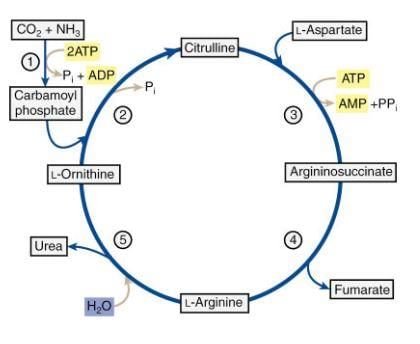CSIR NET Life Sciences Mock Test - 7 - UGC NET MCQ
30 Questions MCQ Test CSIR NET Exam Mock Test Series 2025 - CSIR NET Life Sciences Mock Test - 7
Determine the ratio of volumes of cylinders c1 and c2 if their heights and radii are in the ratio 7 : 9 and 3 : 4 respectively.
A student takes an 18-question multiple-choice exam, with four choices per question. Suppose one of the choices is obviously incorrect, and the student makes an 'educated' guess among the remaining three choices for each question. What is the expected number of correct answers?
Kanak ranks ninth from the top and  from the bottom in a class. How many students are there in the class?
from the bottom in a class. How many students are there in the class?
 from the bottom in a class. How many students are there in the class?
from the bottom in a class. How many students are there in the class?Varshika purchases a dress for Rs. 3200 but the shop had another paying option of Rs. 1000 as a down payment and two equal monthly installments of Rs. 1200 each. Find the rate of interest in the installment scheme.
If 1/4, 1/x and 1/10 are in HP, then find the value of x.
Polythene chromosomes are found because of _____?
Which of the following form of lipids are also referred as neutral lipids?
Which of the following has a major role in the regulation of chloroplast movement?
Which of the following is the best breeding method for animals which are below average in productivity?
Which of these functions is not regulated by intracellular hormone-receptor complexes?
Name the movement of the plant in response to a magnetic field.
Cell cycle is controlled by
P. certain cyclins
Q. certain cyclin-dependent kinases
R. certain inhibitory proteins
S. certain phosphatases
Mendel could not find recombination and crossing over as:
In some flowering plants, the requirement of long day-length or low temperature treatment for flowering can be effectively substituted by:
If VV produces violet flowers and vv produces white flowers, what will be the phenotype and genotype of the F1 progeny?
What is incorrect about the above figure representing DNA replication?
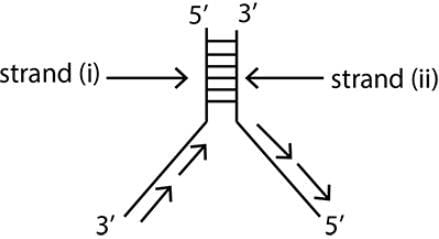
Run off transcription assays were performed to establish the specificity of three novel sigma factors for their promoters. Results of the experiments are shown below:
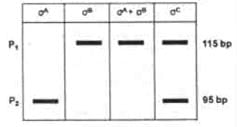
Following inferences were made from these results:
A) sA initiates transcription from P2 and sB from P1.
B) sC can initiate transcription from both promoters.
C) sB prevents initiation of transcription from P2.
D) sA initiates transcription from P1.
Choose the option that correctly interprets the results.
What are the possible phenotypes that can be observed after self-crossing violet flowered pea plants?
Which of the following is the most reliable method of soil remediation?
Which of the following statement is not correct?
1. Six unusual bases are observed in a tRNA molecule.
2. Unusual bases pseudouridine and dihydropyridine are most commonly found in the tRNA molecules.
The terms expressing some of the developmental events or specific body structures are given in column X and the names of animals that are associated with them in column Y:
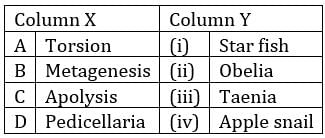
The correct match of the terms in column X with the name of animals in column Y is:
During wing development in chick, if Apical Ectodermal Ridge (AER) is removed, the limb development ceases, on the other hand placing leg mesenchyme directly beneath the wing AER, distal hindlimb structures develop at the end of the wing, and if limb mesenchyme is replaced by non-limb mesenchyme beneath AER, the AER regresses. This may demonstrate that:
(A) the limb mesenchyme cells induce and sustain AER.
(B) the mesenchyme cells specify the type: wing or limb.
(C) the AER is responsible for specifying the type: wing or limb.
(D) the AER is responsible for sustained outgrowth and development of the limb
(E) the AER does not specify the type of wing or limb
Which combination of the above statements is demonstrated by the experiment?


 (r → radius and h → height)
(r → radius and h → height)

 =
= 
 =
= 
 = (
= ( × (
× ( ) = (
) = ( ) × (
) × ( ) =
) = 



 (Kanak position from the top)
(Kanak position from the top)  (Kanak position from the bottom)
(Kanak position from the bottom) 



 students in the class.
students in the class.

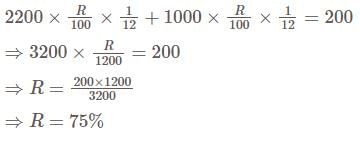





 direction on
direction on 
 strand because it adds them at the
strand because it adds them at the  end. Since, the two strands of DNA run in antiparallel directions, the two templates provide different ends for replication. Replication over the two templates thus proceeds in opposite directions. One strand with polarity
end. Since, the two strands of DNA run in antiparallel directions, the two templates provide different ends for replication. Replication over the two templates thus proceeds in opposite directions. One strand with polarity  forms its complementary strands continuously because
forms its complementary strands continuously because  end of the latter is open for elongation. It is called leading strand. Replication is discontinuous on the other template with polarity
end of the latter is open for elongation. It is called leading strand. Replication is discontinuous on the other template with polarity  because only a short segment of DNA strand can be built in
because only a short segment of DNA strand can be built in  direction due to exposure of a small stretch of template at one time. Short segments of replicated DNA are called Okazaki fragments.
direction due to exposure of a small stretch of template at one time. Short segments of replicated DNA are called Okazaki fragments.
